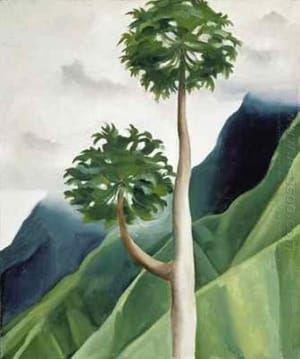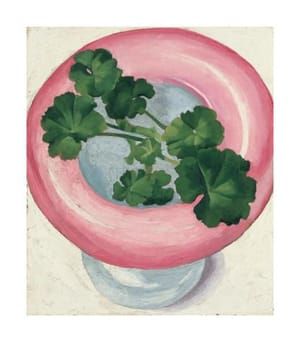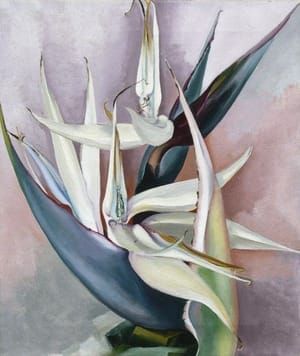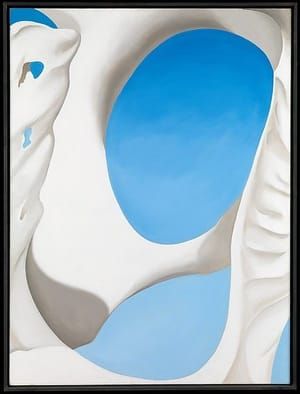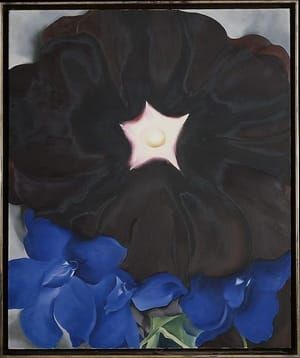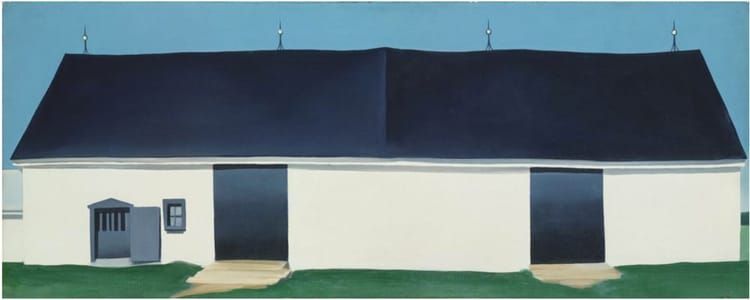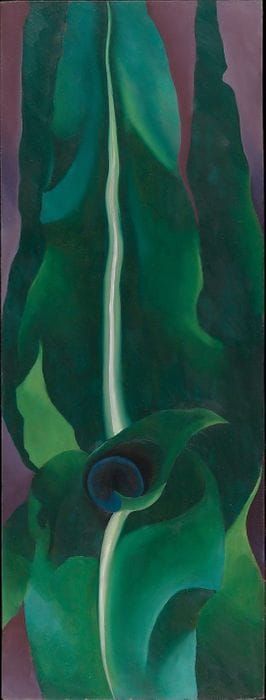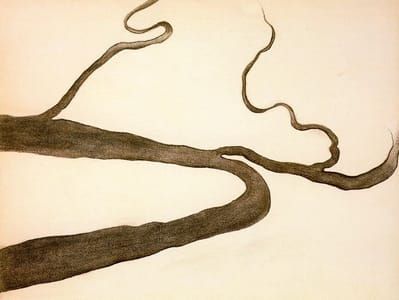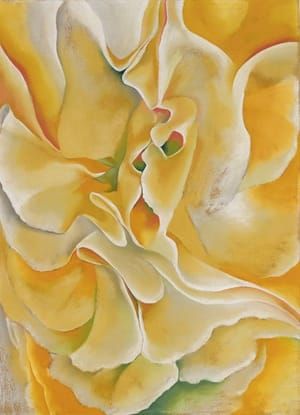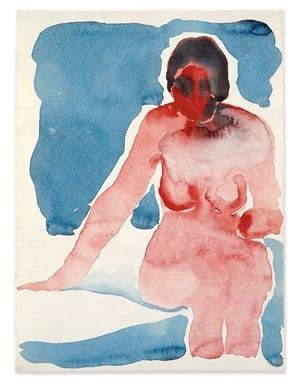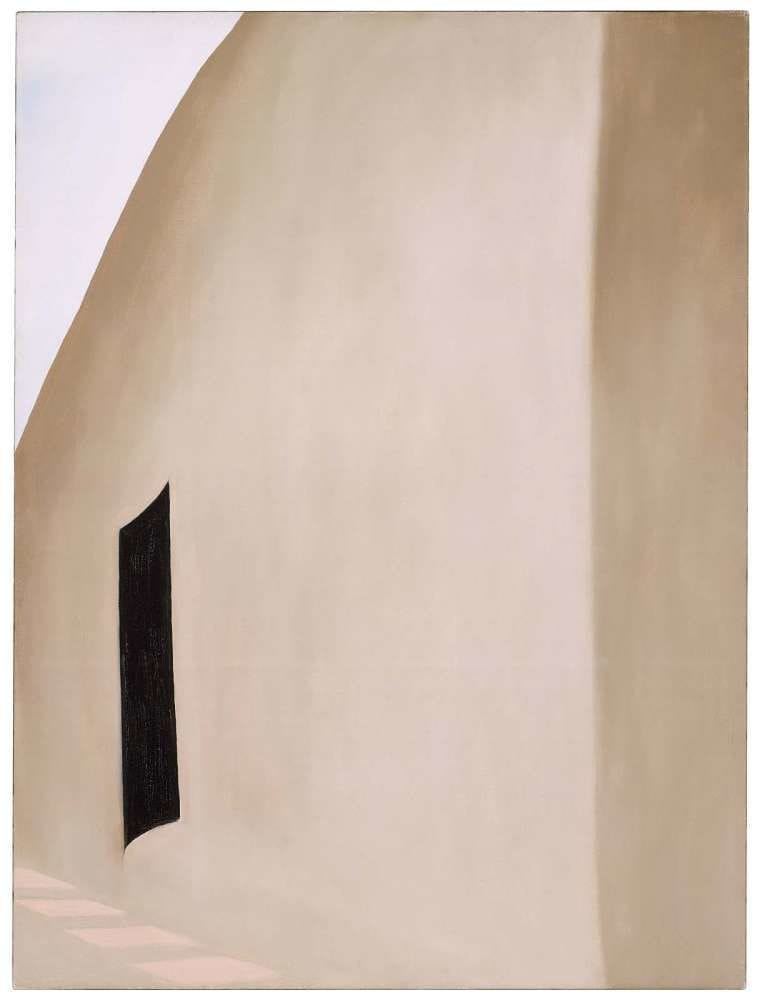

Patio with Black Door, 1955
Georgia O'Keeffe
In 1945, Georgia O’Keeffe purchased and, with the help of her friend Maria Chabot, began to restore a 5,000-square-foot (464.5-square-meter) ruined Spanish Colonial residential compound in the small hilltop town of Abiquiu, New Mexico. O’Keeffe would own the property until her death in 1986, and its spaces and vistas inspired many of her paintings, including several depictions of the enclosed adobe patio at the heart of the complex.
Abiquiu was attractive to O’Keeffe for both practical and aesthetic reasons. Located approximately fifty miles (80.5 kilometers) north of Santa Fe and sixty miles (96.6. kilometers) west of the bustling artist’s colony of Taos, Abiquiu offered peace and solitude, qualities O’Keeffe felt that she needed in order to paint. It was also situated a short distance from O’Keeffe’s Ghost Ranch, a smaller and more secluded building set on an arid plain near breathtaking red and yellow cliffs. O’Keeffe had spent a part of almost every year at Ghost Ranch beginning in 1936, but she knew that the property was too isolated and insufficiently weatherproofed to be habitable during the winter months. Purchasing the Abiquiu property would make it possible for O’Keeffe to live in New Mexico year-round.
In 1946, O’Keeffe’s husband, the photographer and art dealer Alfred Stieglitz, died after a long illness, and thereafter she felt free to spend the majority of her life in New Mexico. Within three years she had fully restored the Abiquiu house, making it a safe and comfortable place to spend the cold and snowy northern New Mexico winters. The property had also come with legal rights to the town’s communal water and irrigation system, an enormously important consideration in the high desert environment. O’Keeffe was thus able to grow and preserve her own food at Abiquiu, provisioning both of her homes and maintaining a high degree of self-sufficiency.
Though these practical considerations were important, O’Keeffe also chose the Abiquiu property for aesthetic reasons. She was deeply attracted to the simple beauty of the Spanish Colonial adobe house, with its graceful mud walls and simple rectangular living spaces. Above all, she was drawn to the large enclosed patio at the heart of the Abiquiu complex, which was walled on all four sides but open to the sky. In her 1976 book, O’Keeffe described her first visit to the building:
"When I first saw the Abiquiu house it was a ruin with an adobe wall around the garden broken in a couple places by falling trees. As I climbed and walked about in the ruin I found a patio with a very pretty well house and bucket to draw up water. It was a good-sized patio with a long wall with a door on one side. The wall with a door in it was something I had to have. It took me ten years to get it—three more years to fix up the house so I could live in it—and after that the wall with a door was painted many times. "
O’Keeffe’s fascination with this space resulted in a series, executed between 1946 and 1956, of over 20 paintings and drawings of the subject. Though these compositions vary widely in both size and color scheme, each includes the distinctive geometric forms of O’Keeffe’s patio. Frequently displayed during her lifetime, the series contains some of O’Keeffe’s most lyrical and abstract Southwestern work. Important examples were purchased by major collectors including William H. Lane and significant institutions such as the Amon Carter Museum, Fort Worth, Texas.
O’Keeffe’s 1948 canvas In the Patio No. IV, painted before restorations to the Abiquiu compound were complete, presents a straight-on view of the adobe wall that O’Keeffe found so intriguing. It shows the large square black door O’Keeffe described at center, with a second door topped by a typical New Mexican–style triangular lintel at right. This subtle painting quietly emphasizes that the adobe wall, made with local soil, is utterly indistinguishable from the earth floor of the patio, which begins at the base of the two doors. Many modernists who traveled to New Mexico championed traditional adobe architecture for just this reason; they believed it was intimately tied to the land from which it was formed.
Patio with Black Door, made in 1955, is one of O’Keeffe’s most striking paintings of this subject. This composition shows the interior adobe wall of the enclosed patio at a sharp angle, with O’Keeffe’s favorite black door on the left. Though it may at first appear that O’Keeffe has taken some license with the shape of the lower part of the door, her depiction is in fact quite representational: a low rounded adobe banquette protrudes from the patio wall in the foreground and cuts off the view of bottom of the door. Unless one is familiar with the patio, it is also difficult to interpret the light pink-brown squares, which are square paving stones that run along the edge of the wall. Connected to its subject matter by the barest of references, this work is above all a quiet meditation on the infinite variety of shades of adobe, earth and sky.
[http://www.mfa.org/collections/object/patio-with-black-door-35103]
Uploaded on Jan 10, 2018 by Suzan Hamer
Georgia O'Keeffe
artistArthur
Wait what?
